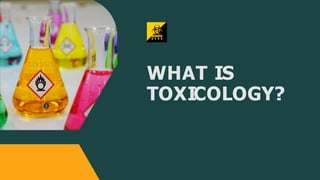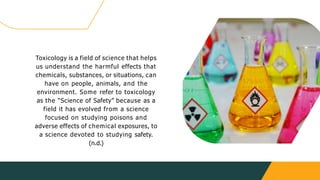- 1. WHAT IS
TOXICOLOGY?
- 2. Toxicology is a field of science that helps
us understand the harmful effects that
chemicals, substances, or situations, can
have on people, animals, and the
environment. Some refer to toxicology
as the “Science of Safety” because as a
field it has evolved from a science
focused on studying poisons and
adverse effects of chemical exposures, to
a science devoted to studying safety.
(n.d.)
- 3. OCCUPATIONAL
DISEASES IN THE
WORKPLACE
Toxicology is intrinsically related to occupational
diseases. Many workers develop occupational
diseases due to long-term exposure to chemicals,
radioactive materials, and other harmful substances.
As such, today’s workers are better safeguarded
from toxic substances in the workplace. However,
progress has also brought about new occupational
diseases and hazards, and exposed workers to new
types of toxic gases, chemicals, and other
substances that have been discovered or man-made
over the years. These newly emerging toxins
continue to plague workers causing new health risks
and health effects even as state-of-the-art
techniques are used to analyze the effect of these
chemicals on human health.
- 4. Respiratory diseases
Contact dermatitis
Musculoskeletal disorders
TYPES OF OCCUPATIONAL
DISEASES
Mental disorders
Cardiovascular diseases
Occupational cancers
- 5. When employers embark on
workplace risk-assessment to
identify possible toxin
contamination in work areas,
exposure of workers to toxic
substances and develop
methodologies to safeguard
workers from adverse impacts
from pollutants, the following
factors must be considered.
KEY
CONSIDERATIONS
OF TOXICOLOGY
The length or period of
exposure to the chemical
toxin;
The dose (i.e. amount)of
substance exposure;
Pre-existing medical
conditions;
The metabolism of the
individual;
Gender, age, weight, etc.;
Allergies and drug
reactions;
An individual’s habits
(smoking, medication use,
alcohol consumption
nutritional intake, etc.);
The method of exposure –
inhalation, ingestion,
injection, and absorption;
and
Type of exposure –direct or
indirect exposure, acute
exposure, chronic exposure,
or accidental exposure.
- 6. Accordingly, OSHA has developed
Occupational Exposure Limits (OELs) for
different air-borne toxins related to a
range of occupations, industries,
chemicals, and toxic substances. While
stipulating Permissible Exposure Limits
(PELs) which are based on 8-hour time-
weighted averages (TWA), OSHA also
specifies Ceiling and Peak limits which
must be compulsorily adhered to by
employers. While many of the details
are available in the applicable sections
of the General Industry, Construction,
Shipyard Employment, Marine
Terminals, and Longshoring regulatory
standards, the most up-to-date
information is available as an Annotated
Table.
OSHA AND
TOXICOLOGY
- 7. HOW CAN WORKERS
LEARN ABOUT
TOXICOLOGY IN THE
WORKPLACE?
OSHA’s requirement to train workers before
they start work at construction sites and other
worksites exposed to hazardous substances
ensures that employees will receive relevant
training on toxicology. The subject of
toxicology is covered in several of our training
courses such as the HAZWOPER 40 Hour, the
HAZWOPER 24 Hour, and the HAZWOPER 8
Hour Refresher. Aspects of toxicology related
to different hazardous substances such as
asbestos and hydrogen sulfide are included in
subject-specific training courses developed
by us.
- 8. FOR INQUIRIES,
CONTACT US.
EMAIL
info@HAZWOPER-OSHA.com
WEBSITE
https://hazwoper-osha.com/
CALL US
1-866-429-6742








